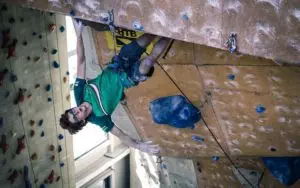One of the key pieces of rock climbing kit is the harness. It’s a crucial link in the belay lifeline, wrapping our waists and thighs with padded webbing that catches us and helps catch our climbing partners in the event of a fall. The climbing harness experiences relatively low wear and tear (at least in most climbing situations), meaning the harness you choose will likely remain in your kit for a few years. To help you make that first important choice, Mountain Skills Academy & Adventures brings you our guide to choosing the right rock climbing harness. To see all of our rock climbing courses and tours click here

Fit and Comfort
The most important consideration when shopping for a rock climbing harness – especially when learning the sport – is fit. Too big and the harness will ride up above your waist creating pressure points. Too small and you’ll lose ready access to your gear loops. The fit is also a significant factor when it comes to comfort level while sitting (hanging) in the harness and when standing or walking.
Depending on your body type, the waist belt will either sit at waist height or on the hip bones. It should be cinched firm with enough room for two or three fingers to slip between the harness and your body.

The leg loops should be reasonably snug but don’t need to fit as tight as the waistband. Leg loops come adjustable on some models (great if you have to attach crampons when alpine climbing) but many harnesses come with fixed leg loops to save weight.
One design factor to be wary of with harnesses is the distance between the waistband and the leg loops, known as “rise.” This is more an issue for women’s body types as the hips-to-waist ratio can vary a lot more. The ideal rise for your body type is the one that lets you hang in the harness without feeling like you’re being thrown forward or backwards.
Speaking of hang time, make sure to spend adequate time in the harness from a vertical hang point to check its fit and comfort on all the aforementioned parts of the harness. Then unclip and see how it feels moving around. If you intend to use the harness as more of an emergency device such as glacier travel, make sure you have adequate freedom of movement and good integration with a large, loaded pack.

Utility
Now that you’ve narrowed down the field to a few well-fitting climbing harnesses, it’s time to look at what you’ll be using the harness for. If you intend on spending most of your time at the local climbing gym or attempting outdoor top rope routes or sport climbs then a sport harness should do the trick. These have little or no leg loop adjustment and minimal gear loops, but are also light and offer greater freedom of movement.

Traditional (trad) harnesses are built to carry a lot more gear while staying as light as possible. They usually come with more padding on the leg loops and waist belt to keep you comfortable for extended periods of hang time. They also usually come equipped with a haul loop at the back of the waistband to haul up another rope, a pair of shoes or other gear. Trad harnesses also come in ice/mixed variations that allow convenient storage for ice screws in cold conditions.

Alpine or mountaineering harnesses are meant to be worn with packs, with easy on and off preferably without having to remove your boots. The focus is on maintaining freedom of movement and breathability, whilst keeping it light and compact for when the harness is stowed.
For the Kids
Harnesses for kids have generally scaled down versions of adult climbing harnesses, with the exception of small children. Children under five years old and under 40kg should wear a full-body harness to accommodate the larger head–to–torso ratio. Kids can then upgrade to a sit harness once they grow sufficiently lower their centre of gravity towards the lower half of their torsos.

Living with your choice of rock climbing harness
As with most outdoor gear, there’s never a perfect piece of gear. At some point one most settle for a trade-off, and it’s a personal choice as to whether you want your harness geared more for one application over another. Always take care of your harness by storing it in a cool dry place and inspecting it regularly for wear and tear. That way you can comfortably climb in your harness for years to come.
If you’re in need of some new footwear be sure to check our guide Choosing the Right Rock Climbing Shoe. We also offer courses for introduction to outdoor rock, sport and trad climbing, as well as rock rescue clinics.
updated June 11th 2018

